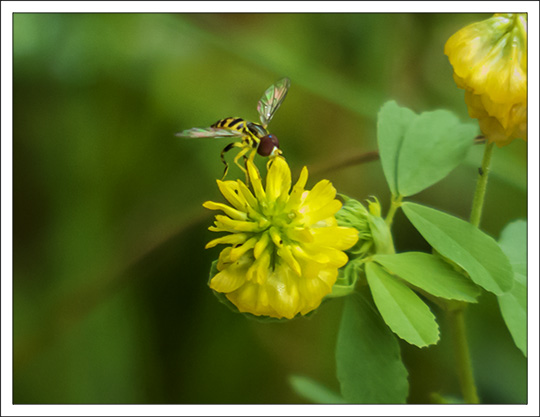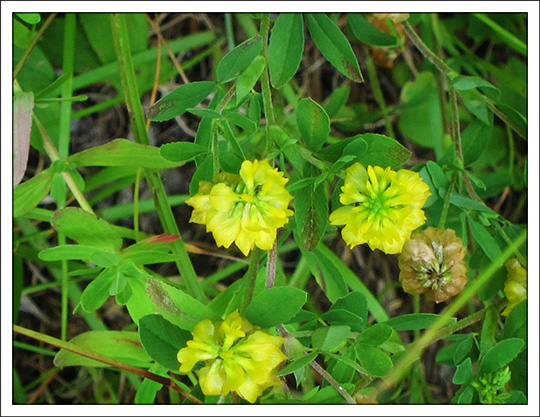Adirondack Wildflowers:
Hop Clover (Trifolium aureum)
 Adirondack Wildflowers: Hop Clover (Trifolium aureum) on the Logger's Loop Trail (20 July 2013)
Adirondack Wildflowers: Hop Clover (Trifolium aureum) on the Logger's Loop Trail (20 July 2013)
| This page is no longer being updated. For an updated and expanded version of this material, see: Hop clover (Trifolium aureum). |
Hop Clover (Trifolium aureum) is a non-native plant which produces bright yellow flower clusters in the summer. The flowers are arranged into small, elongated round head-like cluster. The clusters are 1/4 to 1/2 inch across. As they age, the flowers become brown and paper-like. Like all clovers, this plant has leaves divided into three leaflets. The leaflets of the Hop Clover are stalk-less, in contrast to those of a similar plant -- Trifolium campestre -- which has stalked leaflets.
Hop Clover is a member of the Fabaceae (Pea) family. It is also known as Golden Clover, Yellow Hop Clover, Greater Hop Clover, and Palmate Hop Clover. The genus name -- Trifolium -- refers to the three-parted leaves. The species name -- aureum -- is Latin for "golden." The scientific name for this plant is listed as Trifolium agrarium in field guides..
Hop Clover is not native to the Adirondacks or to North America. It is a Eurasian plant which was introduced in 1800 as a pasture crop. Not all introduced species are considered invasive: plants that have become serious environmental pests. In fact, many non-native species do not cause any problems at all in their new environment.
Hop Clover appears to fall into that category of introduced species which do not cause drastic changes in ecology. Although Hop Clover appears in the Invasive Plant Atlas of the United States, it is absent from other invasive plant lists. USDA, for instance, does not list Hop Clover (Trifolium aureum) as an invasive plant. The plant does not appear on the Federal Noxious Weed List. Nor does it appear on any of the state noxious weed lists. Hop Clover does not appear among the species profiles provided by the National Invasive Species Information Center. Nor does the plant appear in the New York Botanical Garden's Catalog of Invasive Plant Species in the United States. The New York Invasive Species Clearinghouse does not include it on its list of 183 nonnative plant species. Hop Clover is not listed among the invasive plants under study by Cornell University's Ecology and Management of Invasive Plants Program. Hop Clover is not among those species targeted by the Adirondack Park Invasive Plant Program. These data suggest that Hop Clover is not considered to be a serious environmental threat.
 Adirondack Wildflowers: Hop Clover (Trifolium aureum) on the Barnum Brook Trail (18 July 2012)
Adirondack Wildflowers: Hop Clover (Trifolium aureum) on the Barnum Brook Trail (18 July 2012)
Hop Clover grows in part shade and sun along roadsides and trails and in disturbed areas, successional fields and waste places in many locations in the Adirondack Mountains and upstate New York. The plant is naturalized throughout much of eastern North America, as well as many of the western states and Alaska.
At the Paul Smiths VIC, Hop Clover may be seen along the many of the trails, including the Heron Marsh Trail, Barnum Brook Trail, Logger's Loop Trail, Boreal Life Trail, and Bobcat Trail. It usually blooms in this part of the Adirondack Park from late June through early September, depending on the weather.
References
- United States Department of Agriculture. Plants Database.
- NatureServe Explorer. Online Encyclopedia of Life.
- University of Wisconsin. Robert W. Freckmann Herbarium.
- Connecticut Wildflowers. Wildflower Guide.
- Minnesota Wildflowers. Database.
- New York Flora Association. New York Flora Atlas.
- ENature. Wildflower Field Guide.
- Lawrence Newcomb. Newcomb's Wildflower Guide (Little Brown and Company, 1977), pp. 58-59.
- Roger Tory Peterson and Margaret McKenny. A Field Guide to Wildflowers. Northeastern and North-central North America (Houghton Mifflin Company, 1968) pp. 150-151.
- National Audubon Society. Field Guide to Wildflowers. Eastern Region. (Alfred A. Knopf, 2001), pp. 347-348.
- Steven Clemants and Carol Gracie. Wildflowers in the Field and Forest: A Field Guide to the Northeastern United States (Oxford University Press, 2006), pp.184-185.
Information on Non-native Plants
- United States Department of Agriculture. List of Federal Noxious Weeds.
- United States Department of Agriculture. Composite List of Federal and State Noxious Weeds.
- Invasive Plant Atlas of the United States.
- National Invasive Species Information Center. Species Profiles.
- New York Invasive Species Clearinghouse. Invasiveness Assessment Scores and Ranks for 183 Nonnative Plant Species in NYS.
- The New York Botanical Garden. Catalog of Invasive Plant Species of the United States.
- Cornell University. Ecology and Management of Invasive Plants Program.
- Adirondack Park Invasive Plant Program. Terrestrial Invasive Plant Project.
